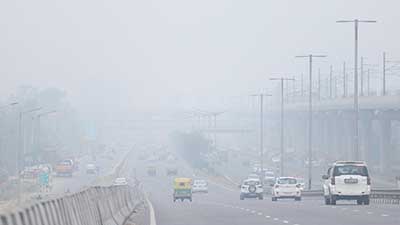Relevance: GS-3: Conservation, environmental pollution and degradation, environmental impact assessment
Key Phrases: Indian Council for Medical Research (ICMR), Real time Data collection, Airshed Boundaries, knowledge-based solutions, satellite-based high resolution imagery, Smog towers, drone-based plume monitoring
Why in News?
- India’s poor air quality not only stands out as a public health concern but also an impediment to economic growth.
- A study by the Indian Council for Medical Research (ICMR) found that air pollution killed 16.7 lakh Indians and also wiped out ₹2.6-lakh crore from the economy in 2019.
Beijing Model: Economic Growth with Environmental Conservation
- For instance, China invested RMB 1.8 trillion to meet its 2017 air quality targets, and generated RMB 2 trillion of GDP growth at the same time.
- The measures taken included phasing out coal-based heating from nearly six million households by 2017, eliminating small-size coal burning boilers and reducing overcapacity in iron, steel, cement and coke industries by nearly 300 million tonnes during 2013-17.
- The country’s determination extended to eliminating almost 30 million outdated ICE vehicles and building metro networks to boost public transport in major cities.
- Most importantly, however, China deployed thousands of sensor-based monitors to boost hyperlocal monitoring and deployed large teams on source apportionment studies.
California Model: Institutional Arrangement to Counter Air Pollution
- The California Air Resources Board (CARB) set a precedent in identifying automobiles and industry as point sources of pollution back in the early 1950s.
- It then used its autonomy to mandate vehicle emissions standards that were stricter than the federal average.
- California has signed several bilateral and multilateral agreements on zero-emission vehicles, and has adopted cap-and-trade programmes and hydrogen fuel cells to reduce vehicular greenhouse gas emissions.
Commission for Air Quality Management (CAQM): Right Blend of Beijing and California Model
- Triple Mandate: Commission’s constitution mandates a triple role — Enforcement, Monitoring, and Research and Development — but as an enforcer, CAQM requires strengthening and augmentation by bringing onboard more full-time experts.
- R&D: CAQM can also improve existing modelling capacity in research by conducting extensive validation and data assimilation.
- The CAQM was set up as a response to the need for inter-State coordination in Delhi NCR for any hope of lowering pollution levels.
- Real time Data collection: Transparency and accessibility of real-time data between States and agencies are key to rapid decision-making before the problem exacerbates, as we witnessed in the 2021 winter yet again.
- Airshed Boundaries: The most positive step has been the recognition that air knows no boundaries and the CAQM thus needs regional coordination, although it is yet to establish administrative airshed boundaries for air quality management.
- Air District: If an airshed can be demarcated which identifies the air flow and pollutants over a region, it can help create an ‘air district’.
- The current district administrations are not equipped with the capacity, capability and mandate for pollution reduction, but the Commission can work more effectively by setting up ‘air districts’ to allow for a decentralised command system.
Way Forward
- Another innovation would be to crowdsource knowledge-based solutions.
- Focus on technical interventions, such as lending satellite-based high resolution imagery with air quality sensors.
- The method provides unprecedented information about the location and intensity of polluting sources.
- Set up Smog towers, being hailed as a short-term solution by cities across India, assessments of artificial rain by cloud seeding can prove to be more cost effective and also alleviate droughts amidst growing climate change uncertainties.
- Other inventions include utilising drone-based plume monitoring to forecast dispersal trajectory in NCR states of Delhi, Punjab, Haryana, Rajasthan and Uttar Pradesh.
Conclusion
- As Delhi NCR is struggling to maintain the air quality standards required, it makes a case for making the region’s air quality laws more stringent like CARB did for California more than 50 years ago. The right blend of knowledge-based solutions, technologies and management can make the Commission much more effective.
Mains Question:
Q. Stubble burning is a October-November phenomenon, however, Delhi Air Pollution is a perennial issue existing throughout the year. In this context, discuss various Natural and Anthropogenic factors responsible for Delhi Air Pollution and suggest some out of box measures to curb this chronic problem.( 15 marks)
Source: The Hindu BL







